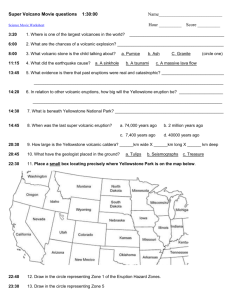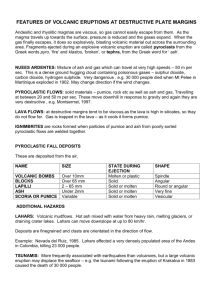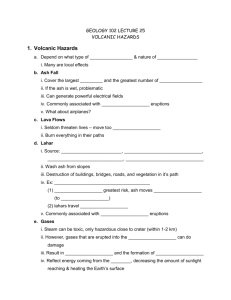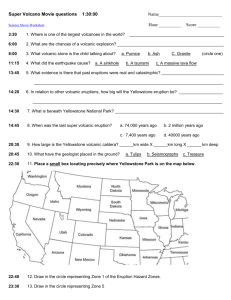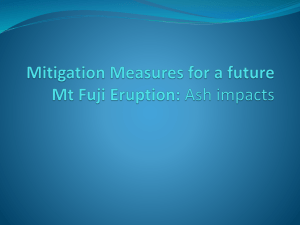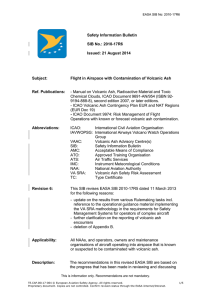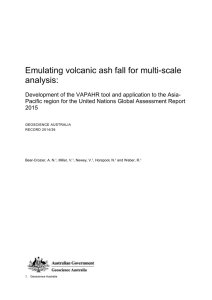12647918_TW VISG Poster Talk - 26 September 2013.pptx (10.11Mb)
advertisement
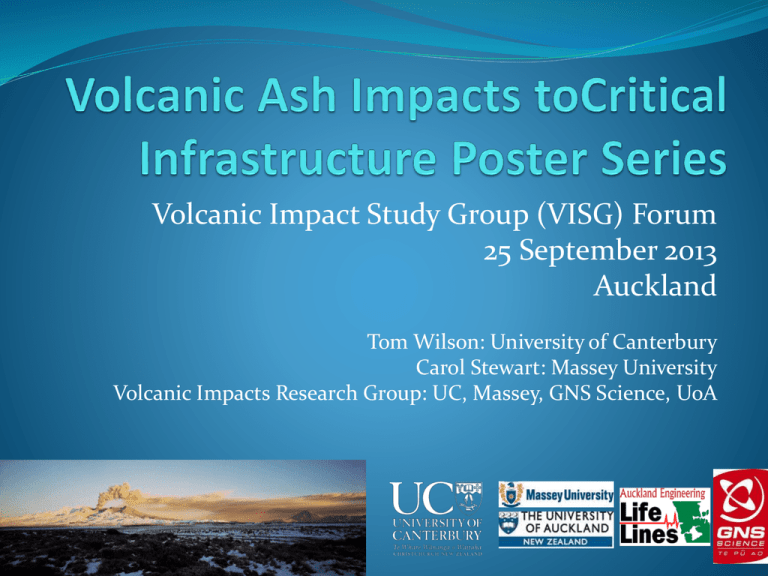
Volcanic Impact Study Group (VISG) Forum 25 September 2013 Auckland Tom Wilson: University of Canterbury Carol Stewart: Massey University Volcanic Impacts Research Group: UC, Massey, GNS Science, UoA Context – Ash Impacts • Volcanic ash is the most likely volcanic hazard to affect the most people during an explosive eruption • Typically disruptive, rather than destructive • Although can potentially create a variety of unique impacts • Wide range of potential ash sources and characteristics makes it difficult to estimating what impacts will be… • Thickness, grainsize, leachate, etc. • Limited evidence base – compared to other perils Lessons from 1995-96 Ruapehu eruption Widespread and costly impacts to engineering lifelines: $10-30 million (1995/96) from a small eruption Paton et al. 1998. Organisational Response to a Volcanic Eruption. Disaster Prevention & Management 7 (1): 5-13 Insufficient knowledge of volcanic hazard impact and appropriate mitigation strategies within responding organisations Insufficient access to required information further exacerbating uncertainty for preparedness, response and mitigation decision-making No agency had the required integrated capability for this applied knowledge Disaster occurred in a complex multi-jurisdictional setting which required well-established pre-existing networks between information providers and responders So what was done about it? Acted as a catalyst for: Developing a greater evidence-base of volcanic impacts to enhance preparedness and mitigation decision making (particularly for ash fall) Enhance communication and coordination structures between volcano scientists and stakeholders Volcanic Impact Study Group Research Context – Ash Impact Research • • • Over the past 10-15 years the New Zealand research group (and collaborators) have aimed to undertake a sustained and systematic approach to volcanic impact assessment - critical infrastructure: electricity, water supplies, wastewater, land and air transport, telecommunications - ash cleanup and disposal - primary industries, including agriculture - social impacts - emergency management Reconnaissance trips to impacted areas to bring lessons home Followed by laboratory testing of critical infrastructure components...VAT Lab Recon Trips: by volcano & year visited Redoubt 1996; 2010 Eldfell (Heimaey) 2008 Shinmoedake 2011 Etna 2003 Sakurajima 2001 Pacaya 2010 Pinatubo 2007 Merapi 2006 Tungurahua 2005; 2010 Lapevi 2003-05 Ruapehu 1995-96 Puyehue Cordon-Caulle 2012 Hudson 2008 Chaiten 2009 Reconnaissance Trips 1) How did impacts unfold in real situations, what were main problems, what was resilient/tolerant (just as important) what mitigation actions were effective, previous preparedness, lessons learned, adaptive behaviours, etc 2) Trips conducted at various time intervals afterwards 3) Trips range from small scale (1 person), to larger multi- disciplinary teams 4) Emphasis on collaborating with local authorities, scientists, and utility managers 5) Development of standardised impact assessment procedures Consistent findings Unexpected. Exotic. Unexpected impacts. Unexpected interdependencies. Ash was difficult and expensive to clean up. Can we mitigate? Where do we find information? “Wish we had planned for this…” Poster Series 1: 2006-2010 Single sectors Short, well summarised, authoritative reference posters considered optimal Chop down long, boring reports Wide application BCP, CDEM exercises, international... Tongariro eruption Volcanic Ash Testing Lab Identified some components/systems are vulnerable, or might be vulnerable Laboratory testing Electricity – flashover Water – floc/coag Computers – damage & function loss GenSets – filter fragility/replacement Contaminated with 3mm ash 2012-13: Revision & Expansion EXISTING “SECTOR” POSTERS: Updated and revised with an expanded knowledge base Valuable interaction with each sector 2012-13: Revision & Expansion NEW CROSS-CUTTING POSTERS Buildings, GenSets/HVAC, Computers and Urban Clean Up Target knowledge gaps Seed funding from AELG thesis research projects Common Design Consistent layout across all posters Modernise Foster recognition Specialised Deliberately designed as fact- and advice-rich resources for a specialised audience Minimise volcano jargon Sector specific terminology Accurate & authentic trust Content - what to include? Sector specific Incisive reviews from AELG members extremely valuable Relies on pointing to wider resources Ash impacts website IVHHN Development and extension of networks Review process...CAROL HELP! AELG Partner organisations used where needed e.g. BoP Lifelines, CAA, Ministry of Health, ESR Number of cycles long and tedious, but worth it (we think...)





